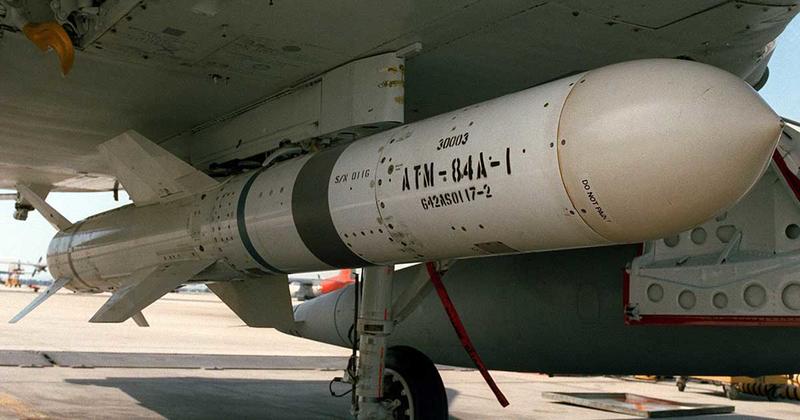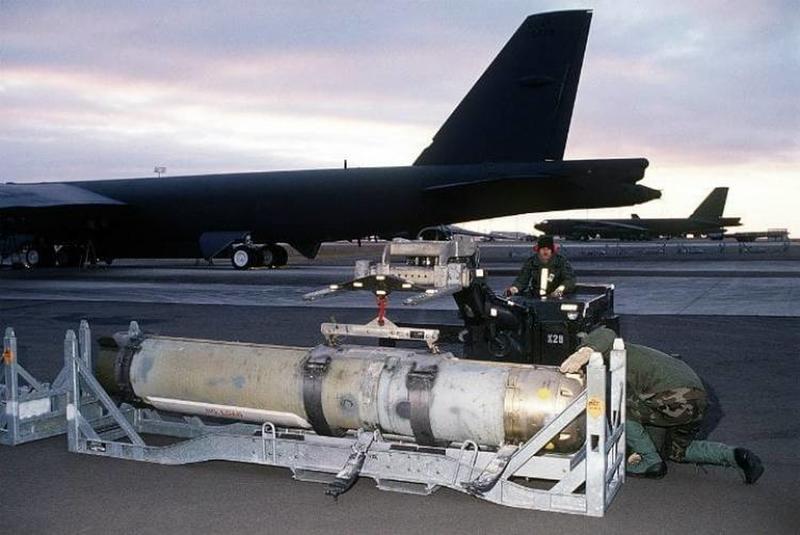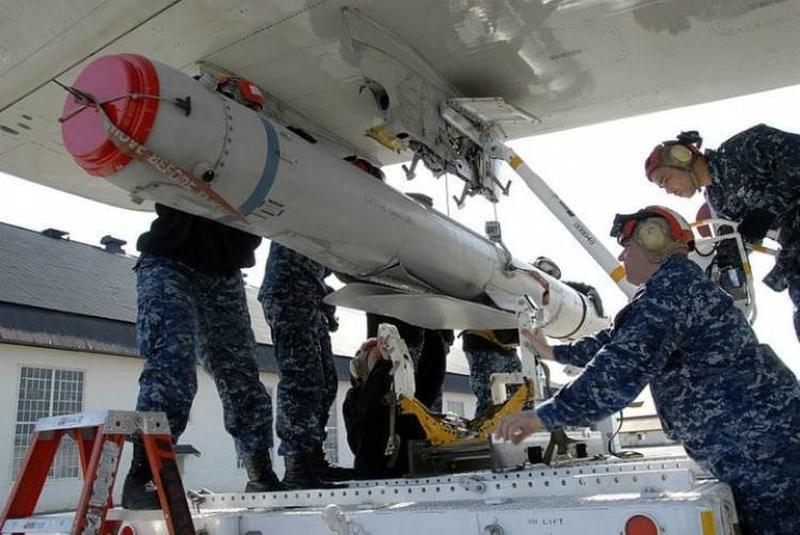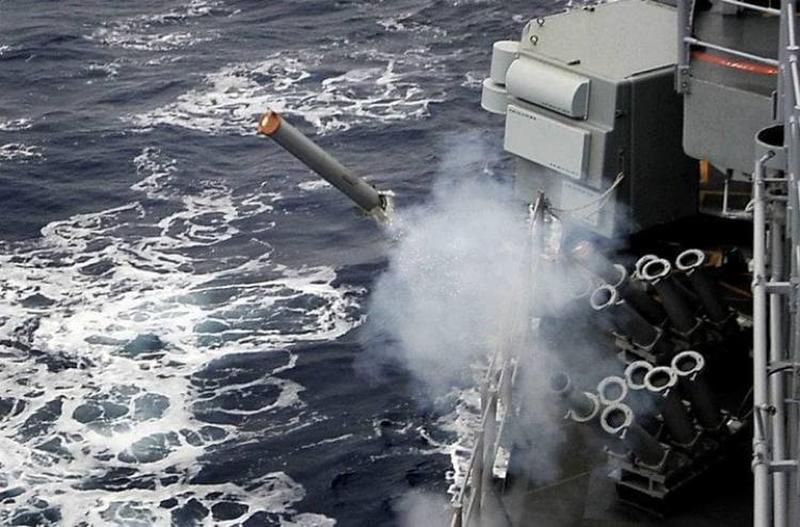While the status of the Navy's nuclear armaments is a closely guarded secret, there's plenty of information available about the incredible weapons which we know for sure that the US is packing. Some of them sound like they're from science fiction movies - they have to be seen to be believed.

Picking a fight with the United States military isn't a good idea. The US war machine is one of the most powerful - if not the outright strongest - in the entire world. The Navy contains over three hundred thousand active members, with a further one hundred thousand on reserve if required.
There's more to the Navy than just the men and women who serve in it, though. With a budget of several billion dollars, the US Navy has access to some of the most technologically-advanced and devastating weapons imaginable. The four thousand ships and aircraft of the Navy are heavily armed.
You'll find this missile listed under the 'short range' category, and it's in service with NATO as well as the US Navy. It's a radar-guided surface-to-air missile, designed to shoot threats out of the sky. They're so accurate that they could even intercept and destroy a cruise missile.

They're not a new invention - they've been around since the 1970s - but they've been refined several times since their introduction. Current models have a fragmenting warhead to inflict maximum damage upon a target at the point of impact.
If you're familiar with Greek myths and legends, you'll know that 'Aegis' means 'shield.' AWS is the ultimate water-based defense system. It's not a singular device; it's a control methodology used to guide weapons, and also remotely issue instructions to them.

The latest computer and radar technology combines within AWS to pick up on threats at the earliest possible moment, and mobilize a means to neutralize the threat - and then target and destroy whatever the threat came from.
Within the US Navy, the Evolved Sea Sparrow is referred to as 'ESSM,' and much of the information about their range and effectiveness is top-secret. It's a surface-to-air missile which operates at medium range, and is so accurate that it can destroy an enemy missile even it's moving faster than the speed of sound.

This is an expensive weapon - each missile costs almost one million dollars! The ESSM range is currently being upgraded, with a new generation of the missiles entering service in 2020.
This weapon was born out of a collaboration between the military minds of the United States and Germany. The missiles are extremely powerful, and can take out enemy threats including missiles and planes up to ten miles away from the point of launch.

The 'rolling' part of its name comes from the fact that it remains stable in the air by rotating on its longitudinal axis; it's the only weapon the US Navy owns which is capable of such sophisticated flight.
Under the Presidency of George W. Bush, much media attention was given to the US's development of so-called 'Star Wars weapons.' The electromagnetic railgun is one of them.

No chemicals are involved in the firing of projectiles here - the powerful forces of electromagnetism are deployed to launch at speeds of up to 5,600 miles per hour, causing total devastation on impact. Put simply, this is a rocket launcher powered by magnets, and nobody within a 100-mile radius of it is safe.
You've heard of the harpoon. You've heard of the missile. But have you ever heard of the harpoon missile? You have now! This adaptable device, which costs over a million dollars per launch, is fitted to a variety of submarines, warships, and even aircraft.

They're reliable enough to be fired accurately in any weather conditions, and they can strike from nearly 70 miles away. When they do land, they detonate a 488lbs warhead. They were originally devised purely as anti-ship missiles, but are now used against many different targets.
Penguins are very cute. This missile is not. The only thing that the weapon and the animal have in common is their incredible navigation skills. The penguin missile, which operates from short to mid-range, can twist, turn, and weave its way to its target to avoid obstacles.

Generally speaking, the targets tend to be large enemy ships. The warhead operates on a time delay, which means it detonates a few seconds after the missile has embedded itself into a target. Planes, ships, and helicopters all use them.
Of all the weapons that the US military can call upon, this is one of the most universally feared. The existence of the Trident II missile is what puts America's enemies off the idea of launching nuclear weapons at the country.

Every Ohio-class submarine has 20 of them, ready to be fired at a moment's notice. Just a single one of them would be enough to wipe North Korea off the map. Five or six of them would completely destroy Russia's electrical grid.
Any US ship on the water is at risk of a submarine attack from below. This is the rocket which makes submarines think twice about trying it. It launched up into the air, flips over, and then plunges back into the water to torpedo the offending submarine.

The weapons work in conjunction with AWS - which we mentioned earlier - to ensure that deployment is swift and accurate. Thirty-eight other countries also own and operate these deadly weapons, which are manufactured in the USA by Lockheed Martin.
It might not have the catchiest name you've ever heard, but the AIM-120 AMRAAM is a standard part of the arsenal of all the US's military aircraft. Whenever you hear that the US has conducted an airstrike, this is the missile that's been fired at the target.

They're also used in air-to-air combat situations. The US has made this missile available to 36 of her allies, although a new model will enter US military service in 2020.
This is one of the best-known tools of the US Navy, and not without good reason. The range of a Tomahawk cruise missile is incredible - they can land with precision on a target over a thousand nautical miles away.

That means they can be fired by submarines and ships at sea, and reach targets which lie far inland from them. GPS systems and cameras help operators to ensure they stay on the right path, and make it all the way to their intended destination.
You might think that this missile was named after the iconic Tom Cruise character in the hit movie 'Top Gun,' but the AGM-65 Maverick was around long before the film.

This is a standard-issue air-to-ground missile which is used against a variety of targets, including heavy-armor vehicles and transport hubs. During both of the wars in Iraq during the past thirty years, the AGM-65 Maverick has seen heavy usage. More than five thousand of them were fired during Operation Desert Storm alone.
The name suggests that this isn't something you should get excited about - but standard or not, you wouldn't want this missile landing outside your front door. They're standard because they're incredibly adaptable, and can be fired at almost any target whether in the sea, in the air, or on land.

The SM-2 variant of the missile is the Navy's first-choice defense weapon in surface-to-air scenarios, and shoots down anti-ship missiles. The SM-6 will also take care of the aircraft that fired them.
With a name that suggests that it takes the enemy prisoner, the Mark 60 CAPTOR isn't a missile, but a mine. It won't take any prisoners when it detonates, though. Every mine is actually a steel shell which houses a torpedo, and sits at the bottom of the sea waiting for a target to appear.

When they're put into the water, they can remain there in an operational state for several months until an enemy target appears - at which point it will self-launch.
Often abbreviated to MK48, this torpedo is worthy of the name 'heavyweight.' Its bulk means it's only effective at the comparatively short range of five miles, but when it slams in its target at 30 miles per hour, it detonates a 650lb warhead.

You'll find MK48s aboard every American submarine currently in service, and they can be directed toward other submarines, or enemy ships on the surface. Homing technology means that they're highly unlikely to miss once they've been launched.
Just as the Mark 48 Heavyweight Torpedo is abbreviated to MK48, the Mark 45 Gun is abbreviated to MK45. It's an automatic 62 caliber gun which you'll find fitted to a number of different cruisers and destroyers, and can be turned on any target regardless of whether they're in the air, on land, or out at sea.

As many as 20 rounds per minute can be fired at targets almost 15 nautical miles away. It's apparently even more accurate than a guided missile.
It has a name that sounds like 'slammer,' and that's a fair approximation of what it does! The SLAM-ER is a guided cruise missile, and is highly regarded within the Navy for its precision accuracy. It's not a Navy exclusive - all branches of the US armed force have access to it.

Each missile, which costs half a million dollars, can be remotely controlled in order to track and strike a moving target. They're made by aircraft manufacturer Boeing.
What more do you need to know than the name? It's called an advanced gun system, and that's exactly what it is! This cutting-edge weapon was built for one specific vessel; the USS Zumwalt, which is the most advanced warship in the Navy's entire fleet.

The AGS is a 155mm gun mounted on a turret, and with a range of 63 nautical miles, they can fire over three times farther than the standard guns fitted to other destroyer-class ships.
When it comes to a battle for aerial supremacy, this is the missile which usually results in the US emerging as the victor. It's getting a little old now, but there's no need to replace it when it's still so good at what it's designed to do.

According to US military statistics, more than 250 enemy planes have been shot down using AIM-9 Sidewinders over the years. It's one of the cheapest missiles the Navy owns, but also one of the most trusted.
You probably already know that a scalpel is a tool used by a surgeon to make precise incisions into a patient. The US Navy's SCALPEL is just as precise - but it's a bomb. SCALPEL stands for Small Contained-Area Laser Precision Energetic Load.

Boiling all of that down into layman's terms, this is basically a bomb guided by laser technology. A SCALPEL can land in an urban location and take out a target without causing widespread damage to the area around it.
The name of this weapon almost makes it sound like something you could buy at your local convenience store. Needless to say, you can't. You'll find at least one of these bombs on all eleven of the enormous aircraft carriers which currently serve US interests.

Once they've been lifted into the air, they're deployed as airdrops from directly above their targets - although they can be combined with guidance technology to improve their accuracy. They're blunt instruments, but they're effective.
'Vulcan' is the name of the home planet of Mr. Spock from 'Star Trek.' If you're a Trekkie, you might recall that the Vulcans came to the human race in peace. M61 Vulcans do not such thing.

They're an integral part of all 3,700 planes currently in the service of the US Navy, and their rate of fire is frightening. M61 Vulcans are effectively rotary Gatlin guns which can fire off 100 rounds every second. That's a powerful barrage.
Very few people have pleasant feelings towards locusts; there was a plague of them in the Old Testament, and their reputation hasn't improved much since then. Locusts operate in swarms, and so do these sophisticated drone devices. LOCUST stands for Low-Cost UAV Swarming Technology, and they launch in swarms of 30.

They confuse enemy radar and technology, attracting fire away from larger planes and interfering with their communications arrays. As they're unmanned, they're completely expendable - and they're also cheap to manufacture.
The pronunciation of this weapon catches a lot of people off-guard. 'Phalanx' is easy enough, but the remainder of the name should be spoken as 'sea-whizz.' CIWS is an acronym for Close In Weapon System, and is used against missiles fired at ships.

Each Phalanx CIWS contains 20mm Vulcan cannons, and the system is fitted to all of the Navy's surface vessels. Some people think they look a bit like R2-D2 from 'Star Wars,' but the cute little robot was never this deadly.
The issue with bombs is that while they're enormously destructive, they're not the most accurate weapons in the world. Paveway laser-guided bombs were designed to change that. Using Paveway bombs means fewer munitions are required to eliminate a target, and therefore bombing raids are more successful.

They were a major factor in the successful removal of Saddam Hussein from Iraq in 2003, having been used in over half of all the precision-guided strikes against his forces and military infrastructure.
The US Navy's radar systems are excellent, but many potential enemies of the US have their own high-quality radar systems, too. That means eliminating enemy radar is a priority when it comes to gaining an advantage.

The AGM-88 HARM is the standard tool for such eliminations; it's an anti-radiation missile that actively seeks out enemy radar installations, and destroys them. The technology in its nosecone can locate electrical activity from over 80 miles away, and the weapon has seen action in both Iraq wars.
Nobody benefits from a military standoff. This weapon ends them. JSOW is a massive air-to-surface missile that weighs in at 1000lbs, and can be mounted with several different warheads - including nuclear if so desired. It's precision-guided, and is capable of penetrating even the most heavily-defended enemy positions.

JSOW was an innovation of the 1990s for use against land-based targets, but subsequent improvements in the technology mean it's now effective on moving targets at sea, too. Further improvements and refinements are in the pipeline.
Nobody refers to this weapon by its full name, because it would take too long to speak out loud! For clarity, it's the Super Rapid Bloom Offboard Countermeasures Chaff and Decoy Launching System. We defy anyone to make sense of that title, and in truth, this is a difficult weapon to explain.

It doesn't launch missiles - it launches decoys to confuse and distract enemy missile targeting systems. The advanced systems have been commonplace among many of the world's advanced navies since 2010.
Once again, much of the information you need to know about this weapon is contained in the name. There's more to this torpedo than just being light, though - it's also incredibly agile. Once fired, the torpedo can duck and dive through enemy fire, avoiding anti-missile weapons and slamming into enemy submarines.

It was developed as a response to the introduction of modern, fast-moving submarines by hostile nations, and can be launched from the air, or by ships on the surface.
This is the naval weapon of the future. The merits of fitting ships with actual laser beams have long been debated, but trials of the Laser Weapon System aboard the USS Ponce back in 2014 have confirmed that they have excellent potential.

This is an energy weapon with various intensity settings; at a low level, it can fire off warning shots. Turn it up to its maximum level, and it will completely fry its target as if it had been put into a microwave.